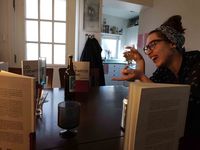Writing Communal Poetics in Isolation
By Dani Spinosa
Wednesday was April Fool's Day. It was also the day that my debut poetry collection, OO: Typewriter Poems (Invisible Publishing, 2020), officially launched. The day was largely symbolic; I and several other readers have had the physical book in our hands for weeks before this official launch date. But, it was the book’s birthday and it was exciting. Or, it was supposed to be exciting. I spent the day inside. I mean, I guess we all did.
True, the launch party we had originally scheduled (and had since postponed) was supposed to be on April 17th, so it wasn't even the party I was missing. It was the community that rises to congratulate an author that felt absent. I have been blessed with a wonderful community of local and international writer friends, and we did our little digital celebrations online together. I even shared a silly party that I had with all my books on Instagram, and my friends, colleagues, peers and I were able to come together a laugh a bit about our situation. Here, for example, is me sharing a drink and a laugh with the birthday books:
I wasn't completely alone on Wednesday. I'm lucky to have my partner and favourite photographer, Jesse, at home with me. And, in the evening, as my pasta bake was in the oven, I met with OO's editor and poet extraordinaire, Gary Barwin, and poet/artist/rebel/writer Mike Sikkema over Skype to talk about visual poetry for Barwin's residency at the University of Toronto. During the conversation, Barwin asked us what seemed like a massive and almost ridiculous question at the time: what is the role of visual poetry as we all write and work in isolation? Or, what do we do with visual poetry in the time of the coronavirus?
The truth is that part of the reason it feels so wrong to celebrate the launch of OO at home with just my partner and our cat beside me is that this a book of poetry in conversation. This is a book that is deeply communal, deeply citational, and heavily indebted to the long tradition of visual poetics and formalist experimentalism that I’ve been reading and writing in for as long as I can remember. Every poem is a love letter to another poem, another poet, another person. And to launch those love letters from a distance feels difficult, even sad.
This book is an uneasy mixture, too, of analogue and digital technologies. Each poem is first written on a typewriter and then scanned into my computer where I digitally alter the product. So, as I’ve said before, when I call this a book of “typewriter poems,” I’m both telling the truth and lying a little. But, digitally launching a book of poems that is uneasily navigating the tension between the digital and the analogue has me thinking about these technologies: what they extend and what they obsolesce. Working on anything, visual poetry included, in isolation is made both better and worse by networked technology. Digital communication, too, is both enabled and made strained/strange in isolation. Nearly every day I get to see my beautiful baby nephew, Theodore, over video chat (which is wonderful), but the sight of his rapid growth, his newly-mastered crawling, his love for ice cream … it all has me longing to pick him up and rub my face in his big fat belly probably more than if I couldn’t see him at all. My eyesight extends, but our ability to touch has been made all the more absent.
Your CanLit News
Subscribe to Open Book’s newsletter to get local book events, literary content, writing tips, and more in your inbox
Visual poetry is almost inherently a communal genre. Because we are not encoding and decoding meaning in the same way that lyric, narrative, or other more sense-making genres do, visual poetry allows other writers to add, alter, translate, and transform the vispo text. And, I think that’s part of what visual poetry does in the time of the coronavirus. It represents a community when we feel distanced. Sometimes it helps. Most of the time, it doesn’t. But visual poetry has provided me comfort in my relative isolation when my focus feels too strained and my motivation too low to make sense and meaning out of sentences, paragraphs, narratives.
And, let’s remember, too, that visual poetry and experimental writing in general is—must be—disruptive. It does not allow for the continual presence of the status quo. And as we all navigate this pandemic in our own isolations, I know that we are thinking more and more about what was the status quo and what we are no longer willing or able to accept as the best or only way to live and work together.
The views expressed in the Writer-in-Residence blogs are those held by the authors and do not necessarily reflect the views of Open Book.
Dani Spinosa is a poet of digital and print media, an on-again-off-again precarious professor, the managing editor of the Electronic Literature Directory, and a co-founding editor of Gap Riot Press, a feminist experimental micro-press. She has published three poetry chapbooks with No Press (Glosas for Tired Eyes, Chant Uhm, and Incessantly) and one with above/ground press (Glosas for Tired Eyes Vol. 2) and her first scholarly manuscript, Anarchists in the Academy: Machines and Free Readers in Experimental Poetry was published by the University of Alberta Press (Spring 2018). She can be found online at www.genericpronoun.com and in person in Toronto.





